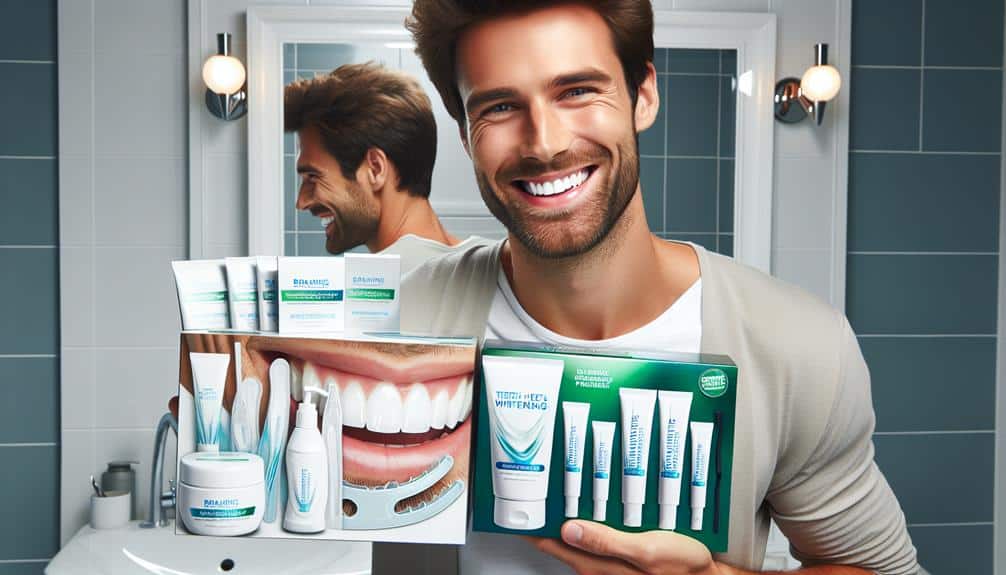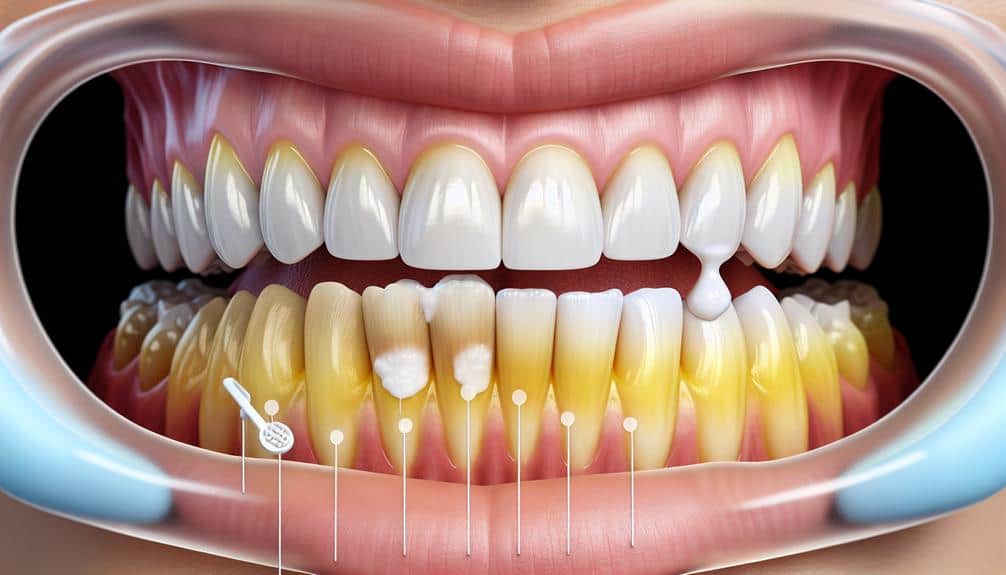For effective solutions to genetic tooth discoloration, choose OTC whitening products ideal for intrinsic staining. Opt for items with hydrogen peroxide or carbamide peroxide like Crest 3D White Whitestrips or Opalescence Go. Crest Whitestrips show quick visible results, while Opalescence Go's pre-filled trays guarantee even application. Prioritize dental health, sensitivity, and enamel protection before whitening. Follow specific product instructions for best outcomes. Consistency in application and timing is crucial. To maintain long-lasting results, practice diligent oral care and avoid stain-causing substances. Ensure a healthier and brighter smile with these recommendations.
Key Points
- Consider genetic factors affecting enamel thickness for effective whitening product selection.
- Opt for OTC products with hydrogen peroxide or carbamide peroxide for genetic tooth discoloration.
- Prioritize enamel-safe formulas to protect teeth while addressing genetic stains.
- Consult a dentist for personalized recommendations based on genetic discoloration factors.
- Maintain whitened teeth long-term with consistent oral care practices and lifestyle adjustments.
Understanding Genetic Tooth Discoloration
If you have ever wondered why some people have genetic tooth discoloration, it's essential to understand the underlying causes. Genetic tooth discoloration, also known as intrinsic staining, occurs due to factors beyond your control. The causes of genetic tooth discoloration can be traced back to your genetic makeup. Certain genes can influence the thickness of your enamel, affecting how much of the underlying dentin shows through. Additionally, genes can play a role in the natural color of your teeth, as well as how prone you're to developing certain dental conditions that may lead to discoloration.
Prevention of genetic tooth discoloration can be challenging since it's primarily determined by your genes. However, maintaining good oral hygiene practices, such as regular brushing and flossing, can help prevent extrinsic staining and keep your teeth healthy. Visiting your dentist for routine cleanings and check-ups is also critical in catching any potential issues early on. While you may not be able to completely prevent genetic tooth discoloration, taking care of your oral health can help minimize its impact.
Top OTC Whitening Products Recommendations
For effective at-home teeth whitening, consider these top recommendations for over-the-counter whitening products. When comparing OTC whitening products, look for those containing hydrogen peroxide or carbamide peroxide as these are effective in removing stains caused by genetics. Crest 3D White Whitestrips and Opalescence Go are two popular choices known for their effectiveness. Crest Whitestrips are easy to apply and provide visible results in as little as a few days. Opalescence Go offers pre-filled trays that adapt to your teeth, ensuring even application and consistent results.
To achieve the best results, follow the application techniques recommended for each product. Most whitening strips require daily use for a specified period, while tray-based systems like Opalescence Go are typically used for 30-60 minutes per day. Results may vary depending on the severity of the stains, but with consistent use, you can expect noticeable improvements in the brightness of your smile. Remember to follow the instructions carefully to avoid any potential side effects and achieve the desired results effectively.
Factors to Consider Before Whitening
Take into account your dental health history and any existing dental conditions before starting any teeth whitening treatment to guarantee safe and effective results. Tooth sensitivity is an important factor to take into account before whitening your teeth. If you already have sensitive teeth, certain whitening treatments may worsen this issue. It's vital to choose products specifically formulated for sensitive teeth or consult with your dentist for personalized recommendations.
Additionally, enamel protection is paramount when whitening your teeth. Enamel is the outer layer that protects your teeth, and some whitening products can potentially harm it if used incorrectly. Look for whitening products that not only brighten your teeth but also help strengthen and protect enamel. Prioritize your oral health by opting for whitening treatments that provide enamel-safe formulas.
Tips for Maximizing Whitening Results
To maximize the effectiveness of your whitening results, guarantee consistent and thorough application of the whitening product as directed on the packaging. Proper application techniques are essential for achieving best whitening outcomes. Make sure you follow the recommended timing for application as specified by the product guidelines. Consistency is vital when it comes to whitening; make it a routine part of your oral care regimen.
In addition to following the application instructions, consider adjusting your diet and hydration strategies to support the whitening process. Avoid foods and beverages known to stain teeth, such as coffee, tea, and red wine, during the whitening period. Opt for teeth-friendly foods that promote oral health, like crunchy fruits and vegetables. Staying hydrated is also crucial for maintaining a healthy smile and supporting the whitening effects. Drink plenty of water throughout the day to wash away food particles and prevent staining.
Maintaining Whitened Teeth Long-Term
Maintain the brightness of your whitened teeth long-term by implementing consistent oral care practices and avoiding habits that may lead to staining.
To guarantee effective whitening maintenance, continue brushing your teeth at least twice a day with a whitening toothpaste containing gentle abrasives to prevent surface stains. Floss daily to remove plaque and debris that can contribute to discoloration between teeth. Consider using a whitening mouthwash to help sustain your bright smile and keep your breath fresh.
Long-term results require avoiding habits that can compromise the whiteness of your teeth. Limit consumption of dark-colored beverages like coffee, tea, and red wine, as well as foods such as berries and tomato sauce that can stain teeth. If you do indulge in these items, consider using a straw to minimize contact with your teeth. Additionally, quit smoking to prevent nicotine stains that can yellow teeth.
Frequently Asked Questions
Can Genetic Tooth Discoloration Be Completely Eliminated With OTC Whitening Products?
Yes, genetic tooth discoloration can be challenging to eliminate completely with OTC whitening products. While these products can help lighten stains, the effectiveness may vary. It's important to manage expectations and consult a dental professional for tailored treatment options.
How Do Genetic Stains Differ From Other Types of Tooth Discoloration?
Genetic stains, tied to your DNA, set themselves apart from other discolorations. Inherited discoloration can make whitening challenging as it's deeply embedded in your tooth's structure. Understanding the genetics of tooth color can shed light on effective treatment approaches.
Are There Any Specific OTC Whitening Products That Are More Effective for Genetic Stains Compared to Other Types of Discoloration?
When tackling genetic stains, opt for OTC whitening products formulated for stubborn discoloration. Their targeted approach enhances effectiveness on genetic discoloration. Experiment with various treatments to discover the most suitable option for your unique dental needs.
Is It Safe to Use OTC Whitening Products on Teeth With Genetic Stains if Other Dental Issues Are Present, Such as Cavities or Gum Disease?
Using OTC whitening products on teeth with genetic stains while having dental issues like cavities or gum disease raises safety concerns. Seek professional advice before treatment. Consider alternative options to avoid exacerbating medical conditions and guarantee peak oral health.
How Long Does It Typically Take to See Results When Using OTC Whitening Products for Genetic Stains?
When using OTC whitening products for genetic stains, it's important to manage expectations. Results vary, but typically you may see improvements in a few weeks. Consistent use is key for efficacy. Be patient and follow the whitening timeline.



